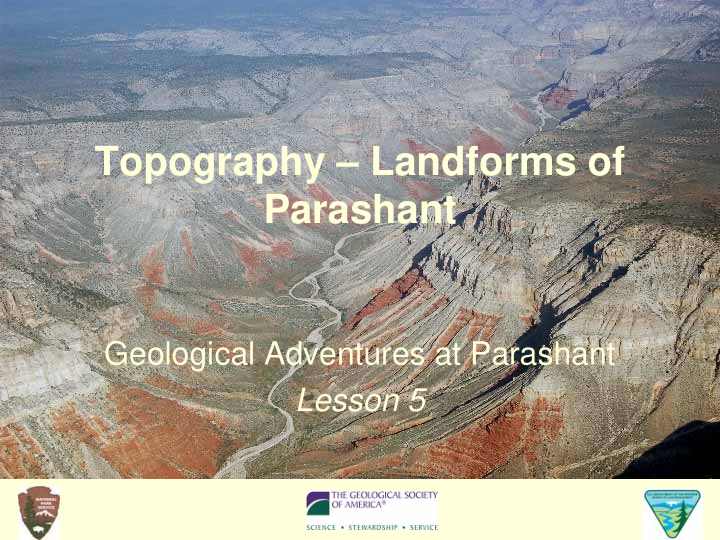



Topography – Landforms of Parashant Geological Adventures at Parashant Lesson 5
Objectives • Contour maps and topographic maps are models of the Earth’s landscapes • How to read a topographic map and draw a topographic profile • How forces and rock materials interact over time to shape the landscape
Materials and Set Up Figure 1 Materials used in Part A of the lesson. Clay used in earlier lessons has been reshaped into a volcanic cone.
Figure 2 Side view of container with model and numbered cm marks.
Figure 3 Model with contour lines drawn on transparency atop the container.
Figure 4 Two examples of contour maps constructed from clay models in water.
Figure 5 A strip of paper laid along the line that connects points A and B is marked with elevations from the contour map. The strip is used to make a profile (see Figure 6).
Figure 6 Tape the paper strip with contour values to graph paper as shown. With a ruler, draw a horizontal line between points A and B and then the two vertical axes. Transfer the contour values to the graph paper as dots. Finally, connect the dots with a smooth line.
FIGURE 5.7 . Part of a topographic map at Parashant. The contour interval is 40 feet. North is towards the top.
Profiles for Map A (Little Springs) and Map B (Grand Wash Cliffs)
Profiles for Map C (Shivwits Plateau) and Map D (Parashant Canyon)
Figures in the Student Text
FIGURE 5.1 . Map of a landscape feature at Parashant. Numbers are feet above sea level.
FIGURE 5.2 Clay model of a volcano in a transparent container.
FIGURE 5.3 Write FIGURE 5.4 Sample contour values for contour lines map. parallel to the lines.
FIGURE 5.5 . Tape a strip of paper to your contour map as shown. Mark the locations of A and B on the strip. Then mark and write down the value of each contour line that crosses the strip.
FIGURE 5.6 . Earth's internal heat drove two factors that control landform development: the uplift of mountains (background) and the eruption of lava (dark rock in foreground).
Table 1. Examples of Landscape Features at Parashant Description Photograph Topographic Map Cinder cone – Large hill several hundred feet high atop plateaus at Parashant. Formed by the eruption of lava, cinders, and ash. The most recent eruption occurred less than 1000 years ago. Butte – A hill that rises abruptly from the surrounding area and which has sloping sides and a flat top. Tops of buttes at Parashant are often capped by resistant sedimentary rock or basalt lava.
Table 1. Examples of Landscape Features at Parashant Description Photograph Topographic Map Canyon – Deep gorges that cut into plateaus. Many canyons at Parashant are lined with washes and lead into the Colorado River in the Grand Canyon. Cliff – High, steep, overhanging face of rock. The large cliffs at or near Parashant like the Hurricane Cliffs shown here and the Grand Wash Cliffs form along faults. Locally, cliffs are often made of sedimentary rock that is resistant to weathering. Wash – The dry bed of a stream that flows only after heavy rains. Often found in the bottom of a canyon. The bottom of a wash is often covered with gravel and sand. Parashant has dozens of washes, but no streams.
FIGURE 5.7 . Part of a topographic map at Parashant. The contour interval is 40 feet. North is towards the top.
Recommend
More recommend